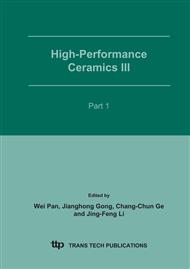p.1279
p.1283
p.1287
p.1291
p.1297
p.1301
p.1305
p.1309
p.1313
Formation Mechanism of Interior Microflaws in the Preparation of Polymer-Derived Silicon Carbide Fibers
Abstract:
Microflaws were detected on the cross-section of polymer-derived silicon carbide fibers and their formation mechanism was studied by varying the curing degree and the firing rate. The results show that microflaws decrease in size with increase of the curing degree due to an increased ceramic residue. The results also show that microflaws decrease in size with decrease of the firing rate. No microflaws are detectable when the firing rate is as low as 10K/h. This indicates that the microflaws are the main channels of evolution gases and the pressure of these gases leads to their formation and propagation. So a high curing degree and a low firing rate are both preferred in the preparation of dense silicon carbide fibers.
Info:
Periodical:
Pages:
1297-1300
Citation:
Online since:
February 2007
Authors:
Keywords:
Price:
Сopyright:
© 2005 Trans Tech Publications Ltd. All Rights Reserved
Share:
Citation:


